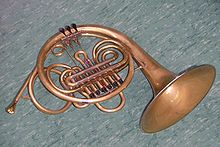Description
The Vienna horn uses a unique form of double-cylinder valve associated with the Viennese firm Uhlmann of the 1840s known as a pumpenvalve. A pumpenvalve is similar to the standard piston valve, but it is not pushed directly inward. Instead, long push-rods reach across to each lever key (as with rotary valves), allowing either a fast or slow change in the valve, by lever speed. The pumpenvalve allows the air to flow straight when the valves are not actuated. When a valve is engaged, each cylinder redirects the air stream 90 degrees in one bend, lessening the resistance felt by the player. This type of valve is one of the many contributing factors to the liquid legato that is one of the trademarks of the Viennese school. However, the indirect linkage between the fingers and the valves can make the action slower and therefore make quick technical passages more difficult for the player. [1]
The internal diameter of the Vienna horn is also smaller than more modern horns. This bore size and shape is actually very close to the design of the valve-less natural horns. The removable crooks (usually an F and A and/or B♭) are also smoothly tapered for the length of the horn. Thus, there is no "compromise" (of dual tubing) as found in the modern double horn and triple horn.
Although subsequent developments, including the rotary valve and double horn, supplanted these horns in most places, the pumpenvalve horn was retained in Vienna because it sounds more like the natural horn: with a more mellow sound and arguably smoother legato. This is due in part to the piston valves and in part to the larger throated (but smaller diameter) bell-flare still used with these instruments. The Vienna horn has remained virtually unchanged since the mid-nineteenth century.
Horn players who use the Vienna horn also use a natural horn mouthpiece, which is less concave than a typical double horn mouthpiece. A standard horn mouthpiece is more concave, partly to facilitate the playing of lower notes because of lower impedance of the double horn. [2]
This page is based on this
Wikipedia article Text is available under the
CC BY-SA 4.0 license; additional terms may apply.
Images, videos and audio are available under their respective licenses.

